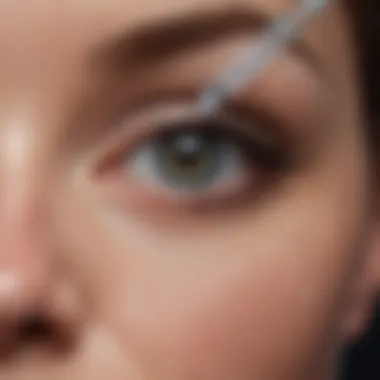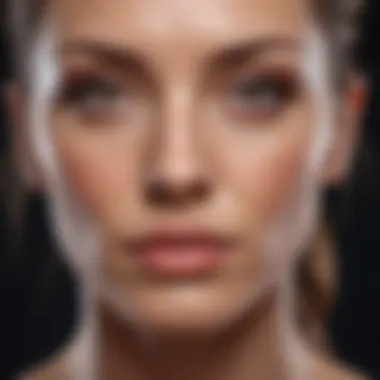Understanding the Risks of Botox Treatments


Intro
Botox, or botulinum toxin, has become a hallmark in cosmetic procedures aimed at reducing wrinkles. While many patients seek this treatment for its efficient results, understanding the inherent risks is crucial. This article deeply explores the dangers associated with Botox, promoting informed decision-making for potential users. Not only does it address common side effects, but it also examines long-term implications and alternative options pertinent to safe cosmetic practices.
The understanding of Botox's full impact on health is essential. The discussion will cover various facets of its applications, assessing both immediate and delayed responses.
Research Overview
Summary of Key Findings
Botox's safety profile appears favorable based on numerous studies. However, there are significant side effects and risks that cannot be overlooked. Some of the most noted side effects include:
- Muscle weakness
- Allergic reactions
- Infection at the injection site
- Headaches, and
- Temporary facial drooping
In serious cases, symptoms such as breathing difficulties or difficulty swallowing can manifest. Moreover, research has indicated that frequent use might lead to resistance to the effects, which can complicate ongoing treatments. Long-term studies are still emerging, making the evaluation of lasting effects in younger patients complex.
Relevance to Current Scientific Discussions
As Botox remains popular, discussions within the scientific community focus on its efficacy versus safety. Most professionals advocate for a cautious approach, suggesting that patients fully understand the risks before proceeding. This aligns with recent debates on ethical practices within cosmetic surgery, prompting further examination of regulation and patient education.
Furthermore, the rise in non-medical personnel offering Botox injections raises concerns over the standard of care and qualifications necessary for such procedures. Ongoing research aims to address these issues and promote safer practices in the industry.
Prologue to Botox
Botox has gained immense popularity as a cosmetic treatment, primarily for its ability to reduce the appearance of wrinkles. Understanding what Botox is and how it works is crucial for anyone considering its use. This section delves into the essential elements of Botox, including its definition and a historical perspective on its usage. By familiarizing readers with these aspects, we can set the stage for a deeper exploration of the associated dangers and risks.
What is Botox?
Botox is a brand name for a substance produced by the bacterium Clostridium botulinum. The active ingredient in Botox is botulinum toxin type A, which temporarily paralyzes muscles when injected. This leads to a smoothening of the overlying skin, effectively reducing the visibility of facial wrinkles. Besides its cosmetic applications, Botox is also used in treating various medical conditions, such as chronic migraines, excessive sweating, and certain muscle disorders. Its multifaceted use has made it a household name in both cosmetic and medical circles.
History of Botox Usage
The use of Botox dates back to the 1980s when it was first approved for treating strabismus (crossed eyes) and blepharospasm (eyelid spasms). Initially, the medical community recognized its therapeutic potential, setting the groundwork for its cosmetic uses. In 2002, Botox received FDA approval for the temporary treatment of frown lines between the eyebrows, marking the beginning of its rise as a cosmetic product. Since then, the popularity of Botox has soared, with millions of treatments administered annually. This historical context is vital for understanding not only the evolution of its usage but also the necessity of addressing its associated risks in a modern context.
Mechanism of Action
Understanding the mechanism of action of Botox is essential in analyzing its safety and efficacy as a cosmetic treatment. This section elucidates how Botox interacts with the body, especially focusing on muscle dynamics and the neuromuscular junction. Grasping these concepts can aid in comprehending potential risks and side effects.
How Botox Works on Muscles
Botox, or botulinum toxin, primarily acts by inhibiting muscle contractions. When injected into a muscle, it blocks the release of acetylcholine, a neurotransmitter responsible for signaling muscle contraction. As a result, the targeted muscle becomes temporarily weakened or paralyzed.
This muscle paralysis serves its cosmetic purpose by smoothing out wrinkles and fine lines caused by repetitive muscular movements. However, while this may seem advantageous, it raises important considerations. It is critical to note that frequent use can lead to unintended consequences such as:
- Muscle atrophy: Over time, the muscles may weaken more than intended.
- Compensatory movements: Other muscles may overcompensate for the weakened muscles, leading to imbalances.
These effects highlight that while Botox can improve appearance temporarily, the underlying muscle dynamics might be altered in the long term.
Effects on Neuromuscular Junction
The neuromuscular junction, where nerve cells communicate with muscles, is significantly impacted by Botox use. This clearance of acetylcholine prevents proper signaling, fundamentally altering the way muscles function.
Moreover, the effects at the neuromuscular junction can extend beyond the immediate area of injection. Potential complications arise when Botox spreads and affects adjacent muscles or even other areas, leading to undesired outcomes. For instance, if injected too close to the eyelid, it may cause ptosis, resulting in drooping and altered vision.
"Botox’s reach is not limited to its injection site; understanding this broad influence is crucial for safety and effectiveness."
Thus, understanding the effects at the neuromuscular junction is crucial for both patients and practitioners. It emphasizes the importance of precise placement and dosage, reinforcing that a thorough understanding of these mechanisms can help in mitigating risks associated with Botox treatments.
Commonly Reported Side Effects
Understanding the commonly reported side effects of Botox is important for anyone considering this cosmetic treatment. Awareness of such effects can help individuals make informed choices and manage expectations regarding their aesthetic goals. The side effects can be broadly categorized into local adverse effects and systemic reactions, each carrying its own set of implications.


Local Adverse Effects
Bruising
Bruising is one of the more common local adverse effects of Botox. It often occurs at the injection site due to minor damage to the small blood vessels. This temporary discoloration can be concerning for those seeking immediate cosmetic improvements. The key characteristic of bruising lies in its visibility; it can significantly affect a person's willingness to undergo the procedure again.
However, bruising generally resolves within a few days, and for many patients, the overall aesthetic outcomes may justify this temporary setback. It's essential to weigh the short-lived nature of bruising against the potential benefits of Botox, which is to diminish wrinkles and enhance appearance.
Swelling
Swelling is another common local reaction after Botox injections. This occurs as the body's natural response to the fluid introduced during the injection process. The prominence of swelling can vary among individuals and might deter some from considering the treatment, particularly if they desire immediate results.
The unique feature of swelling is that it usually subsides within a week but can sometimes last longer, depending on the individual’s sensitivity. Understanding that some degree of swelling is expected can help users cope better with the immediate aftermath of the treatment. The critical consideration here is balancing the attractiveness of treatment results against the aesthetically displeasing short-term swelling.
Pain at Injection Site
Pain at the injection site is a less frequent but notable local effect. Patients might experience a localized discomfort immediately after the procedure. The intensity can range from mild to moderate, and this can impact a patient's overall satisfaction with the Botox process.
Despite being a form of discomfort, the pain is often manageable and diminishes shortly after the procedure. Understanding this aspect adds another layer of expectation management for potential Botox recipients. Overall, while the pain at the injection site can be a disadvantage, it is often overshadowed by the long-term aesthetic improvements that Botox can provide.
Systemic Reactions
Moving beyond local effects, systemic reactions can manifest in several ways, affecting a broader range of bodily functions.
Headaches
Headaches have been reported as a systemic reaction following Botox injections. The occurrence of headaches can be particularly troubling for individuals who already suffer from frequent migraines or tension headaches. The nature of the headache may vary, but many describe it as a dull ache that can last from hours to a few days post-treatment.
Understanding this reaction is crucial because it can deter potential users from proceeding with Botox, especially with awareness that alleviating headaches might require additional medication or treatment.
Nausea
Nausea can also arise after Botox injections. This reaction is not as common but can occur in susceptible individuals. The feeling of nausea can affect a person’s willingness to try Botox again. It is important for potential patients to recognize this possibility so they can prepare themselves mentally and physically.
Fatigue
Fatigue is another systemic reaction that some individuals may experience after the procedure. It can manifest as general tiredness or lack of energy. Though it is typically temporary, this feeling may influence a person’s day-to-day activities, especially in the immediate aftermath of undergoing Botox treatment.
By understanding these systemic reactions, prospective users can make more informed decisions about their cosmetic treatments, considering both the potential benefits and accompanying risks.
Severe Complications
Understanding the severe complications associated with Botox is crucial. Many people overlook the potential negative outcomes while focusing on cosmetic benefits. However, recognizing these complications can lead to better decision-making and heightened awareness regarding safety in aesthetic procedures. Here, we explore specific severe complications that can arise from Botox injections, highlighting the importance of informed choices.
Allergic Reactions
Allergic reactions to Botox are rare but can be serious. Some individuals may develop an allergy to the components within Botox, leading to symptoms such as:
- Itching
- Hives
- Swelling (particularly of the face, lips, or throat)
- Difficulty in breathing or swallowing
In severe cases, an allergic reaction can trigger anaphylaxis, a life-threatening condition that requires immediate medical attention. Patients considering Botox should discuss any prior allergies or sensitivities with their healthcare provider. This helps to assess the risk and prepare for potential reactions. Moreover, it is important to be monitored post-injection for signs of an allergic response.
"While rare, allergic reactions to Botox remind us that cosmetic treatments are not without risks. It's essential to weigh both aesthetic desires and potential dangers."
Botulism and Its Effects
Botulism from Botox is extremely rare but is a severe complication worth noting. Botulism occurs if the botulinum toxin spreads beyond the injection site, leading to muscle weakness or paralysis. Some symptoms include:
- Double vision or blurred vision
- Drooping eyelids
- Difficulty swallowing or speaking
- Weakness in muscles that may spread throughout the body
These effects can vary in severity and can lead to prolonged health issues. The exact mechanism often relates to improper administration or dosages, making it crucial to receive Botox only from licensed and experienced professionals. Patients with pre-existing neuromuscular disorders may face higher risks, highlighting the importance of thorough health evaluations before proceeding with treatment.
Long-term Implications of Botox Use


The long-term implications of Botox use are crucial to consider, especially for individuals who undergo this treatment repeatedly. While Botox is widely regarded as effective for cosmetic improvements, the potential consequences of continuous use can raise significant questions about overall health and well-being. Evaluating these implications is essential for anyone contemplating Botox, aiding in informed decision-making.
Possible Muscle Atrophy
One of the most concerning long-term implications of Botox is the risk of muscle atrophy. When Botox is injected into facial muscles to reduce the appearance of wrinkles, it temporarily paralyzes those muscles by blocking nerve signals. If repeated over an extended period, this inhibition can lead to muscle weakening and even atrophy.
- The extent of atrophy can vary, but generally, the affected muscles may become smaller and weaker.
- Studies have demonstrated that prolonged use of Botox may lead to disuse of specific muscles, which can further enhance the appearance of aging rather than prevent it.
It is critical for patients to understand that maintaining a balance in muscle activity contributes to facial aesthetics. Over-reliance on Botox could detrimentally alter the face's symmetry and expression.
Changes in Facial Muscle Dynamics
Botox can also induce changes in facial muscle dynamics, which some individuals may not anticipate. Facial expressions are a complex interplay of various muscles. Injecting Botox into certain areas can affect how these muscles interact over time.
- Changes in muscle dynamics can lead to unexpected facial expressions that may not align with the individual's desired aesthetics.
- Additionally, compensatory muscle activity may develop in untreated areas. This adaptation can result in uneven expressions or altered facial behavior.
Understanding these dynamics is crucial for individuals considering long-term Botox use. It is recommended that patients consult with medical professionals experienced in cosmetic treatments to discuss these potential outcomes thoroughly.
"The implications of Botox use extend beyond short-term aesthetics. Serious consideration of long-term changes is essential for informed choices."
Regulatory Perspective
Understanding the regulatory perspective on Botox is vital for comprehending its safety and efficacy. Regulatory bodies, such as the U.S. Food and Drug Administration (FDA), play a key role in overseeing the approval and monitoring of Botox treatments. This section will elucidate the processes in place to ensure that Botox is administered safely and that any potential risks are effectively managed. It will also address how these regulations impact patient choices and safety.
Approval Process by Health Authorities
The approval process for Botox involves rigorous assessment and evaluation by health authorities. The journey starts with extensive preclinical studies that evaluate the product's safety and efficacy. Following these trials, the manufacturer submits a New Drug Application to the FDA, which includes data from clinical trials, proposed labeling, and information on the manufacturing process. The FDA then conducts its review, considering factors such as:
- Efficacy data from clinical trials
- Manufacturing quality and consistency
- Risks associated with the treatment
- Proposed usage guidelines
Only after thorough scrutiny does a product receive approval for public use. This stringent process aims to ensure that treatments like Botox meet established safety standards before they are made available to consumers.
Post-marketing Surveillance
Once Botox has received approval and is available in the market, post-marketing surveillance begins. This phase is crucial for monitoring the long-term safety of the treatment. Regulatory agencies continue to gather data on adverse effects that may not have been fully identified during clinical trials. Post-marketing activities involve:
- Collecting reports of side effects from practitioners and patients
- Conducting additional studies to assess long-term impacts
- Re-evaluating the safety profile as new data emerges
By maintaining oversight after approval, health authorities aim to ensure that any emerging risks are promptly addressed, providing an additional layer of safety for consumers.
Alternatives to Botox
The discussion surrounding Botox often focuses on its cosmetic benefits and associated risks. However, it is crucial to explore alternatives that can provide similar aesthetic results without some of the dangers. Understanding these options can empower individuals to make informed choices regarding their appearance and health. Alternatives to Botox can range from dermal fillers to various non-invasive treatments. These methods can offer distinct advantages, such as fewer side effects and longer-lasting results in certain cases. Evaluating these alternatives not only broadens the spectrum of available cosmetic options, it also encourages a more nuanced conversation about safety in aesthetic treatments.
Dermal Fillers
Dermal fillers serve as a popular alternative to Botox, especially for those looking to enhance facial volume or address specific areas such as lips or cheeks. Unlike Botox, which relaxes muscles to reduce wrinkles, dermal fillers are injected into the skin to fill areas of lost volume. The key characteristic of dermal fillers is their ability to provide immediate and noticeable results. They can address fine lines, wrinkles, and hollowness in the face, making them an appealing option for many.
One unique feature of dermal fillers is the variety of substances used in their formulation. Options range from hyaluronic acid to collagen-based fillers. Each type has its own set of advantages and disadvantages. For instance, hyaluronic acid fillers like Juvederm or Restylane tend to be temporary, lasting between six months to over a year, requiring ongoing treatments. However, they often result in a more natural appearance and can be dissolved if necessary.
Non-invasive Treatments
Non-invasive treatments have gained traction as effective alternatives to Botox. These methods can rejuvenate the skin without needles or significant downtime. Two notable non-invasive options are laser therapy and chemical peels.
Laser Therapy
Laser therapy is a method that uses concentrated beams of light to target various skin issues such as pigmentation, fine lines, and overall texture. The appeal of laser therapy lies in its precision and ability to address a range of skin concerns. The key characteristic of this treatment is its versatility. Different types of lasers can be used for specific issues, making it a customizable option.
A unique feature of laser therapy is its capacity for stimulating collagen production, which promotes skin elasticity and improves appearance over time. While many patients experience positive results with minimal side effects, it is essential to note that recovery can vary based on the type of laser used. Redness and temporary discomfort may occur but usually subside within a few days.
Chemical Peels


Chemical peels involve applying a chemical solution to the skin, which causes it to exfoliate and eventually peel off. This treatment can improve skin tone, texture, and the appearance of fine lines. The critical aspect of chemical peels is their effectiveness in treating skin imperfections and promoting smooth skin.
Each chemical peel formula can produce varying degrees of depth, categorizing them into superficial, medium, and deep peels. A unique aspect of chemical peels is their ability to reveal fresher, younger skin after the peeling process. However, caution is advised, as deeper peels may require more downtime and can carry risks such as scarring.
Informed Decision-Making
In recent years, the popularity of Botox as a cosmetic treatment has increased significantly. However, it is crucial to approach this procedure with a comprehensive understanding of the associated risks. Informed decision-making plays a central role in ensuring that individuals are equipped with the necessary knowledge before undergoing any cosmetic procedures. This includes understanding potential side effects, long-term implications, and alternative treatments available in the market.
Understanding the Risks
Understanding the risks related to Botox use is fundamental for anyone considering this treatment. *Botox is derived from botulinum toxin, a substance that can cause severe health complications if misused. The potential side effects range from mild local reactions to serious systemic issues, including allergic reactions and even muscle paralysis. It is essential to assess both the immediate and long-term risks associated with the use of Botox.*
Here are some key areas to consider when evaluating the risks:
- Local Effects: Bruising, swelling, and pain at the injection site are commonly reported. These usually resolve quickly but can be uncomfortable.
- Systemic Effects: Reactions such as headaches, nausea, or fatigue may indicate a sensitivity to the treatment.
- Severe Complications: In rare cases, Botox can trigger severe allergic reactions or botulism, leading to life-threatening conditions.
- Long-term Implications: Muscle atrophy and alterations in facial dynamics might occur over time, potentially affecting natural expressions.
"An informed choice is not just about weighing the pros against the cons; it requires a deep understanding of both, informed by current data and personal health considerations."
Consulting with Medical Professionals
Consulting health professionals is a critical step in the journey of making an informed decision about Botox. A qualified medical practitioner can provide tailored advice based on individual health conditions, history, and aesthetic goals.
Here are some considerations when consulting with professionals:
- Expert Knowledge: Medical professionals possess the experience and training to discuss the complexities of Botox, including proper dosage and potential risks.
- Assessment: A careful assessment of your health can reveal any contraindications. This includes being aware of medications that may interact adversely with Botox.
- Customized Plans: Discussing your desired outcomes with professionals can lead to a treatment plan that aligns with both safety and aesthetic goals.
- Follow-Up Care: Good practitioners will offer follow-up consultations to monitor for any adverse effects and to optimize the results over time.
Case Studies
Case studies play a vital role in understanding the implications and effectiveness of Botox treatments. They provide real-world examples that highlight the potential risks and outcomes associated with this cosmetic procedure. Through these accounts, one can appreciate the nuances of patient experiences and the varying degrees of side effects that may arise.
Documented Adverse Events
Documented adverse events shed light on the darker side of Botox use. These cases often involve severe reactions that are not widely discussed in promotional literature. Research initiatives such as the FDA's database on adverse events offer critical insights into the types of complications encountered by patients.
For instance, there have been reports of patients experiencing unexpected muscle weakness, vision problems, and even respiratory issues following Botox injections. These documented incidents underscore the importance of thorough assessment and continuous monitoring of patients.
Some common documented adverse events include:
- Acute allergic reactions, resulting in swelling and rash.
- Muscle drooping, which can alter facial appearance.
- Systemic spread of the toxin, leading to severe complications.
Understanding these events helps foster an cautious perspective towards Botox, implying that its application should not be taken lightly.
Patient Testimonials
Patient testimonials can provide compelling narratives about the outcomes of Botox treatments. These first-hand accounts can help prospective patients understand the potential risks involved. By reviewing testimonials, readers can gauge the emotional and physical impact of their choices.
Some testimonials reveal a spectrum of experiences ranging from satisfaction with aesthetic results to disappointment owing to side effects. One patient may share a successful experience with wrinkle reduction but caution others about subsequent headaches occurring days after the procedure. Another might recount a serious adverse effect such as muscle weakness that necessitated medical intervention.
In summary, these testimonials offer diverse perspectives, enabling individuals to engage critically with the choice of undergoing Botox treatments. Prospective patients can assess whether the aesthetic benefits align with their willingness to accept the associated risks.
"While Botox can enhance appearance, understanding all potential outcomes is crucial before proceeding."
The combination of case studies and patient testimonials creates a comprehensive narrative which informs prospective patients while emphasizing the importance of medical guidance and self-education.
Ending
The conclusion of an article examining the dangers of Botox serves as a crucial element in reinforcing the significance of understanding these risks. It is important for readers to summarize vital points addressed throughout the analysis, ensuring they leave with a clear awareness of the implications related to Botox treatments.
Summarizing the Risks
In reviewing the various sections, key risks associated with Botox emerge clearly. These include both common side effects, such as bruising and headaches, and more serious complications like allergic reactions and botulism. Emphasizing these risks helps to underscore the potential for discomfort or serious health issues resulting from seemingly benign cosmetic procedures. Furthermore, the long-term implications include muscle atrophy and changes in facial dynamics. Collectively, these factors serve as reminders that Botox is not without significant considerations.
Cultivating Awareness
Cultivating an awareness of these dangers is not solely about understanding risks but also appreciating the importance of informed decision-making. Readers should be encouraged to engage with medical professionals before proceeding with Botox treatments to discuss individual risks and expectations. Education can empower individuals, allowing them to make choices that prioritize health and safety above aesthetic goals. Informing the public fosters a culture of critical thinking regarding cosmetic treatments, encouraging more thoughtful engagements with these procedures.
"Awareness is the first step toward making safer choices in cosmetic procedures."
A comprehensive understanding of both the cosmetic and health implications is essential for anyone considering Botox. This article aims to illuminate the nuances that individuals might overlook in their pursuit of beauty.



